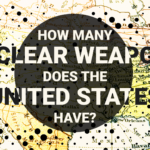UK nuclear veterans timed out?
By Sue Roff | October 3, 2012
Sixty years ago, on October 3, 1952, Britain became an atomic power. More than 22,000 UK servicemen and a handful of women participated in British nuclear tests in the 1950s. There were another 10,000 or so participants who hailed from Commonwealth countries, especially Australia, which was home to the first three test sites, the Monte Bello Islands off the country’s northwest coast, Emu Field on the mainland in South Australia, and the thinly populated Maralinga area of South Australia.
A year before the first test, the Trials Planning Section sent a memo to British Royal Navy Vice Admiral P.W.B. Brooking of the Armament Research Establishment, the laboratory responsible for UK weapons development in the 1950s, informing him that the men sent to work on the tests would be monitored for radiation exposure. “We can in advance estimate, up to a point, what contamination is likely, and we will be able in the event to discover the facts,” the memo stated. “It is not suggested that any one man who took part, and subsequently suffers from a disease which might be due to the [o]peration, should automatically be compensated. I do feel, however, that some formula might be accepted by the [m]inistries which would dispose any tribunal in favour of a claimant.”
In the early years, in fact, participants had their blood tested before they left for the atomic test sites. But those records were subsequently lost, and throughout the United Kingdom’s atomic and nuclear testing program, the military took no steps to alert participants to their possible exposures.
Now, 60 years after the first servicemen sailed for the Monte Bello test sites, the UK Supreme Court has narrowly dismissed a class-action lawsuit by nuclear veterans on statute-of-limitation grounds. The court’s decision, which could affect hundreds of nuclear veterans, illustrates a legal paradox: The participants in the UK nuclear program did not sue the government within a required three-year time frame because they did not have the documentation to prove their radiation exposures caused illness, as the British legal system defines causation. They did not have the documentation, in part, because the government had failed to create or safeguard it.
Losing records and cutting corners. At one time, documentation may have existed on radiation exposures created by atomic testing at the Maralinga site. But as with pre-deployment blood-test information in England, relevant records from the hospital serving participants at the Maralinga site have disappeared. Twelve tests were conducted from 1952 to 1957 on Maralinga, Emu Field, and Monte Bello Islands.
By the time the British weapons testing moved to Christmas Island in 1957, the race was on to build a British hydrogen bomb before the atmospheric test ban treaty came into force. Corners were cut. Nine tests were held between 1957 and 1958 on this spot and Malden Island in the central Pacific Ocean. Sizable detonations were carried out a few miles off the coast of Christmas Island, which is barely 20 miles by 30 miles in area. Instead of being detonated thousands of feet in the air, two of the Christmas Island tests were detonated from balloons on land at 1,476 feet, about the height of the tip of the spire of the Empire State Building. Just the same, the British atomic scientists decided not to monitor radiation exposure of participants because the “[i]ssue of [film] badges at this stage may well provoke anxiety,” not only in the servicemen but also among the Christmas Islanders, according to a 1958 memo from Air Vice Marshal John Grandy to the Atomic Weapons Research Establishment back in England.
In the 1960s, a government official opposed the inclusion of a question relating to radiation exposure in the military services’ documents. In the future, the official wrote, “[t]here might well… be changes in medical opinion on this problem, and we anticipate that in this event we would be gravely handicapped in defending claims for arrears of pension where the member could point out that because of the inclusion of this question we were aware of their exposure to radiation.”
The legal paradox. In March of this year, the UK Supreme Court, ruling on nine test cases, narrowly decided against allowing a class-action lawsuit by more than 1,000 nuclear veterans to proceed. Justice Nicholas Wilson said the action had been raised too late because the appellants had the “requisite knowledge” to bring the case within the three-year statute of limitations set out in British law. “Their many private and public statements down the years about the cause of their conditions; the nation-wide campaign for compensation pursued for so long and with such vigour through the British Nuclear Test Veterans Association; the applications for war pensions; and the applications to the European Court of Human Rights: all these were the product of reasonable beliefs,” Wilson wrote for the majority opinion. At the same time, Wilson held that these beliefs, while strong enough to require initiation of the case years ago, were not proof. He noted that the veterans’ counsel “concedes that even today the appellants lack evidence with which to establish a credible case that the injuries were caused by the tests.”
Even though he wrote a dissenting opinion, Justice Nicholas Phillips also acknowledged, “The most that the veterans as a group are currently in a position to establish is that there is a possibility that some of them were exposed to a raised, albeit low level of fall-out radiation and that this may have increased the risk of contracting some at least of the injuries in respect of which they claim. This falls well short of establishing causation according to established principles of English law.”
But another dissenter, Justice Brenda Hale, pointed out the paradox contained in the majority opinion: If the veterans cannot yet prove a causal link between their presence at the tests and their later illnesses, “the claimants still do not have the knowledge required for time to begin to run [under the statute of limitations].”
In fact, the UK has a pension scheme based on the possibility that participation in the weapons tests induced a person’s cancer or other radiogenic condition. Although the Veterans Agency of the Ministry of Defence routinely denies such claims, I have participated in more than 60 successful appeals against Ministry of Defence denials of pensions to atomic and nuclear veterans. Each case had to be argued on its medical and radiobiological merits before an independent tribunal that included a senior medical official.
The Ministry of Defence successfully argued there was no cause-and-effect relationship between veteran exposure and health effects before the Supreme Court, but the court may have been unaware of tribunal findings in more than 100 cases. But all of the UK’s nuclear partners, including the United States, Canada, Australia, and New Zealand, now have pension and compensation schemes based on the probability that radiation exposure leads to increased incidences of cancer and other diseases, and the weight of the successful appeals against the Ministry of Defence must eventually be given some attention.
If the UK Supreme Court had permitted the cases to go forward, this question — whether the mounting weight of agreement that the possibility of radiogenic causation of cancer and other disease now amounts to a probability — would have been the central issue. Instead, the majority decision dismissed the case without the benefit of hearing scientific argument on harm determinations.
UK atomic and nuclear veterans may have to turn to the European Court of Human Rights — which can make decisions that are binding on the UK and other countries that have ratified the European Convention on Human Rights — if they are to win compensation or a fairer pension scheme. A dozen years ago, they were turned away by that court and told to go back to the UK courts to explore the domestic remedies more fully. The Supreme Court decision means that they have exhausted those UK avenues and will now, perhaps, be eligible for re-consideration.
Editor’s note: This article was updated on October 26, 2012, to correct for an author error on the height of the Christmas Island tests.
Together, we make the world safer.
The Bulletin elevates expert voices above the noise. But as an independent nonprofit organization, our operations depend on the support of readers like you. Help us continue to deliver quality journalism that holds leaders accountable. Your support of our work at any level is important. In return, we promise our coverage will be understandable, influential, vigilant, solution-oriented, and fair-minded. Together we can make a difference.
Topics: Nuclear Weapons, Opinion















